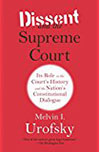
Reviewed by: James G. Apple, Editor-in-Chief, International
Judicial Monitor
Melvin I. Urofsky, professor emeritus of history at
Virginia Commonwealth University in the U.S. and past chair of that institution’s
history department, has focused his writing and teaching career on law-related
subjects, often controversial. Four of his more recent publications deal with
money and free speech, a controversy largely derived from the U.S. Supreme
Court decision in the Citizens United case; assisted suicide; affirmative
action, and death and dying. He is also the author of a definitive and well received biography
of Louis D. Brandeis, one of the great justices of the U.S. Supreme
Court. His latest effort examines an issue that is not greatly controversial, but is
nevertheless an irritant that arises from time to time in many legal systems. That
issue is the role of dissenting opinions in courts, especially appellate
courts.
Many courts around the world, one might even say most
courts, are what is known as collegial courts, that is, in their resolution of
cases, dissenting opinions are not allowed, and a court must speak with one
voice. The issue has not been one without controversy in the United States, and
the U.S. Supreme Court in its 230 years of existence, has conducted its affairs as both a collegial
court, and one that allows dissenting opinions and later, even what are called
concurring opinions.
Professor Urofsky, in his well written book, has now
presented a comprehensive account of the role of dissenting opinions in
American jurisprudence, confining his commentary to the U.S. Supreme Court
(U.S. lower appellate courts generally follow the lead of the “Supremes.” His
account is historical; he starts with the practices of the Supreme Court in
its early years, and then gives an account of the changes made in the Court’s
procedures through the years, to the actions of

 International
Judicial Monitor
International
Judicial Monitor